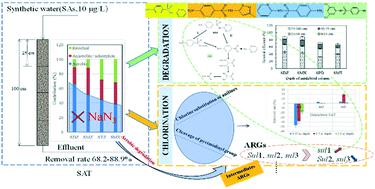当前位置:
X-MOL 学术
›
Environ. Sci.: Water Res. Technol.
›
论文详情
Our official English website, www.x-mol.net, welcomes your
feedback! (Note: you will need to create a separate account there.)
Removal trends of sulfonamides and their ARGs during soil aquifer treatment and subsequent chlorination: effect of aerobic and anaerobic biodegradation
Environmental Science: Water Research & Technology ( IF 3.5 ) Pub Date : 2020-05-19 , DOI: 10.1039/d0ew00270d Kena Qin 1, 2, 3, 4, 5 , Yan Chen 1, 2, 3, 4, 5 , Jianju Li 1, 2, 3, 4, 5 , Chonghua Xue 5, 6, 7, 8 , Liangliang Wei 1, 2, 3, 4, 5 , Xugang Song 1, 2, 3, 4, 5 , Jing Ding 1, 2, 3, 4, 5 , Qingliang Zhao 1, 2, 3, 4, 5
Environmental Science: Water Research & Technology ( IF 3.5 ) Pub Date : 2020-05-19 , DOI: 10.1039/d0ew00270d Kena Qin 1, 2, 3, 4, 5 , Yan Chen 1, 2, 3, 4, 5 , Jianju Li 1, 2, 3, 4, 5 , Chonghua Xue 5, 6, 7, 8 , Liangliang Wei 1, 2, 3, 4, 5 , Xugang Song 1, 2, 3, 4, 5 , Jing Ding 1, 2, 3, 4, 5 , Qingliang Zhao 1, 2, 3, 4, 5
Affiliation

|
Sulfonamides (SAs), the most widely used antibiotics, are frequently detected in wastewater treatment plant effluent. In this study, the removal trends of four typical SAs (sulfadiazine (SDZ), sulfamethoxazole (SMX), sulfapyridine (SPD) and sulfamethazine (SMT)) in lab-scale soil aquifer treatment (SAT) systems, as well as their chlorination behaviors, were evaluated. As much as 68.2–88.9% of SAs in the synthetic water samples (10 μg L−1 initial concentration) were efficiently removed during steady-state operated SAT, which was the highest for sulfadiazine and lowest for sulfamethazine. Specifically, aerobic biodegradation in the soil played a great role in SA removal and contributed 55.7%, 57.8%, 61.1% and 74.0% to SMT, SMX, SPD and SDZ removal, respectively. Cleavage of the aniline group and desulfation of the SAs were the main pathways for their degradation during soil degradation. Subsequent chlorination could partially eliminate the SAs in the SAT effluent but not entirely, with a removal rate of 8.21% for SDZ, 7.45% for SMX, 14.21% for SPD, 16.52% for SMT, respectively. Electrophilic substitution of the aniline group and reaction with desulfation products produced different chlorinated by-products. The intermediates of the SAs originating from the SAT biodegradation contributed to the formation of chlorinated by-products and antibiotic resistance genes (ARGs), especially for organic compounds generated under aerobic biodegradation conditions. Taken together, our findings demonstrated that the abundant existence of SAs in the recharging samples would lead to health concerns due to the high concentrations of ARGs and precursors of chlorination by-products, especially with traditional chlorination processes.
中文翻译:

土壤含水层处理和后续氯化过程中磺酰胺及其ARG的去除趋势:好氧和厌氧生物降解的影响
磺酰胺(SAs)是使用最广泛的抗生素,经常在污水处理厂的废水中检测到。在这项研究中,在实验室规模的土壤含水层处理(SAT)系统中,四种典型的SA(磺胺嘧啶(SDZ),磺胺甲恶唑(SMX),磺胺吡啶(SPD)和磺胺二甲基嘧啶(SMT))的去除趋势及其氯化行为,进行了评估。合成水样品中高达68.2–88.9%的SA(10μgL -1稳态操作SAT期间有效去除了初始浓度),这对磺胺嘧啶最高,对磺胺二甲嘧啶最低。具体而言,土壤中的好氧生物降解在去除SA方面起着重要作用,分别对SMT,SMX,SPD和SDZ的去除贡献了55.7%,57.8%,61.1%和74.0%。苯胺基团的裂解和SAs的脱硫是其在土壤退化过程中降解的主要途径。随后的氯化可部分消除SAT废水中的SA,但不能完全消除,SDZ的去除率为8.21%,SMX的去除率为7.45%,SPD的去除率为14.21%,SMT的去除率为16.52%。苯胺基团的亲电子取代以及与脱硫产物的反应产生了不同的氯化副产物。源自SAT生物降解的SA的中间体促成氯化副产物和抗生素抗性基因(ARG)的形成,特别是对于好氧生物降解条件下产生的有机化合物而言。综上所述,我们的研究结果表明,由于高浓度的ARGs和氯化副产物的前体,尤其是传统的氯化工艺,补给样品中大量存在的SA会引起健康问题。
更新日期:2020-05-19
中文翻译:

土壤含水层处理和后续氯化过程中磺酰胺及其ARG的去除趋势:好氧和厌氧生物降解的影响
磺酰胺(SAs)是使用最广泛的抗生素,经常在污水处理厂的废水中检测到。在这项研究中,在实验室规模的土壤含水层处理(SAT)系统中,四种典型的SA(磺胺嘧啶(SDZ),磺胺甲恶唑(SMX),磺胺吡啶(SPD)和磺胺二甲基嘧啶(SMT))的去除趋势及其氯化行为,进行了评估。合成水样品中高达68.2–88.9%的SA(10μgL -1稳态操作SAT期间有效去除了初始浓度),这对磺胺嘧啶最高,对磺胺二甲嘧啶最低。具体而言,土壤中的好氧生物降解在去除SA方面起着重要作用,分别对SMT,SMX,SPD和SDZ的去除贡献了55.7%,57.8%,61.1%和74.0%。苯胺基团的裂解和SAs的脱硫是其在土壤退化过程中降解的主要途径。随后的氯化可部分消除SAT废水中的SA,但不能完全消除,SDZ的去除率为8.21%,SMX的去除率为7.45%,SPD的去除率为14.21%,SMT的去除率为16.52%。苯胺基团的亲电子取代以及与脱硫产物的反应产生了不同的氯化副产物。源自SAT生物降解的SA的中间体促成氯化副产物和抗生素抗性基因(ARG)的形成,特别是对于好氧生物降解条件下产生的有机化合物而言。综上所述,我们的研究结果表明,由于高浓度的ARGs和氯化副产物的前体,尤其是传统的氯化工艺,补给样品中大量存在的SA会引起健康问题。









































 京公网安备 11010802027423号
京公网安备 11010802027423号